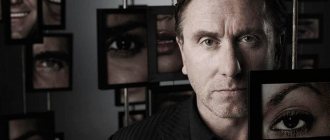Lies have long become an integral part of every person’s life. When telling lies, people can be guided by different motives: deception can be purposeful, aimed at humiliating a person, or it can be unintentional, to save relationships between people. In this article we will consider not so much the reasons for lying, but its signs. You will learn how to activate your internal “lie detector,” which will help you recognize by a person’s facial expressions and gestures whether he is lying or telling the truth.
How to recognize a lie from your interlocutor: counting a liar
The face is the mirror of the soul.
Marcus Tullius Cicero
- 1.How to recognize a lie by facial expressions? 1.1.Symmetry and lies
- 3.1.Step back
- 5.1. Features of lies in the interlocutor’s speech and facial expression
- Praise your man correctly and he will be at your feet!
- How to recognize a lie from your interlocutor: counting a liar
- When is a lie good?
- How to catch lies and insincerity in speech
- How to learn to lie professionally
How often do we lie
People lie to us more often than we think. We ourselves use deception to get what we want, but we don’t always admit it. There is nothing terrible about someone distorting facts if it does not harm other people. The latter includes slander, when one person deliberately tells a lie about another in order to belittle his abilities or elevate his own importance.
If someone deceives out of ignorance, considering his words to be the truth, then such a situation cannot be called a lie. He is in error and, not knowing it, leads those around him into it. There are no selfish motives, but a sediment remains in the soul.
People may not lie, but not tell the truth. This is also considered deception, because a person consciously undertakes this act in pursuit of a goal. For example, a child broke your favorite mug, but is silent about it because he is afraid of punishment. You are looking everywhere and he is watching. This type of lie is driven by fear.
More often we deceive our interlocutors when we do not know them well or know that we will not see each other in the future. Then fantasy takes precedence over reason and you, telling incredible stories, begin to believe in them. There is nothing wrong with such lies, but you need to be aware that you can also be deceived.
We spend more time on the Internet on forums or blogs. Everyone tries to exceed their true importance in society, to show themselves better than others, to remain noticed. This leads to addiction to lies. Having gained authority among the inhabitants of the forum, it will be unbearable for you to lose it and you will lie again and again, because no one will prove the words are incorrect.
We are used to lying at work. Telling lies to customers has become a habit for many companies if they want to gain trust. We also go beyond our merits to get the position we want.
What will help you recognize a lie?
What to do if we live in a world of lies and deception. How not to fall for the bait of swindlers and liars. There is only one answer - learn to recognize lies. This is the only way to protect yourself from people with evil intentions.
Learning to lie is not so difficult, especially if there have been no punishments for lying since childhood. But there is one circumstance that is not controlled by reason. This is the subconscious that knows about lies and reacts to them.
Scientists conducted an experiment: the subjects were divided into two groups, some told lies to unsuspecting people, and others listened to liars, knowing that they were being deceived. The facial expressions and body movements of the first and second were largely the same. This says that the subconscious, sensing deception, begins to react to it.
In the same experimental way, psychologists found out the basic movements, features of behavior and speech of liars and divided them into three groups:
Facial expression. Turning your eyes to the side, avoiding eye contact, tense lips, squinting your eyes. Sign language. Crossing arms and legs, tense posture, fidgeting in one place, twitching arms or legs, nervous movements, scratching the neck or nose. Features of speech behavior. Slow or accelerated pronunciation, confusion in facts, low voice.
These factors should alert you and make you understand that the interlocutor is hiding something. This behavior becomes especially noticeable if you have known the person for a long time or live with him. Therefore, couples who have been married for a long time or close friends intuitively understand that they are being deceived.
But if a stranger lies to you for personal gain, then you need to practice to figure it out. Observing people will help you become an expert in lying. Wherever you are, simply note for yourself the features of behavior, facial expressions and speech. Watch films and TV series, notice the good and bad acting of the actors, what mistakes they make when they act out their dialogue implausibly.
Repeatedly touching your own body
Rubbing your hands, for example, can be a sign of anxiety. A person does not feel safe, so he cannot find a place for himself. His movements are chaotic. He either tries to shake non-existent dust from his clothes, or searches his pockets for a handkerchief. Such fuss should distract the interlocutor from the meaning of the phrases, then the lie will be easier to pronounce. But you already realized that they are telling you lies, right?
Facial expression
According to numerous studies, looking to the right indicates that a person is telling a lie. The fact is that when we have to invent, this is how the eyes behave if we think about it and stop controlling the body. And the movement of the pupils to the right will indicate that the process of remembering is underway and the person is not lying.
Where the gaze is directed also matters. If downward, then the person comes up with tactile sensations or emotions, if upward, then he imagines a visual image, and to the side - sounds.
If the interlocutor deliberately avoids making eye contact, then he is trying to hide the truth or is afraid of getting confused. If a person deliberately glares at you, watches the reaction to his speech, then he guesses whether you believe it or not.
If someone is deceiving, then they subconsciously experience fear of exposure. Therefore, the facial expressions inherent in this feeling betray the interlocutor. When a person is afraid, he involuntarily raises his eyebrows and strains his eyes. At the same time, wrinkles appear between the eyebrows and in the outer corners of the eyes. Liars have tense lips and clenched teeth even during conversation.
Liars try to smile at you in order to gain your trust and create a friendly atmosphere. But this smile differs from a sincere one in many ways. The lips are too elongated and tense, one corner of the mouth is raised higher than the other (a gesture of contempt).
Behavior during provocations
Increased breathing, heaving of the chest, frequent swallowing, protruding perspiration - these are signs of strong feelings. It is possible that they are lying to you. Blushing is a sign of embarrassment, but you can also become embarrassed from shame for lying.
Do you like field hockey?
If you try to abruptly change the subject, the person telling the lie will take it with relief and support your initiative, because he understands that the less you talk to him, the less chance he has of “messing up” and giving himself away.
If the interlocutor is sincere, then his natural reaction will be a misunderstanding of the reason for the change of topic, dissatisfaction that his story was not heard to the end. He will try to return to the topic of conversation. I don’t like you guys...
If you have doubts about the veracity of the interlocutor’s words, MirSovetov advises to implicitly show that you do not believe the interlocutor’s story: after his answer to the next question, pause, look closely, with distrust. If they are not honest with you, it will cause embarrassment and uncertainty. If a person tells the truth, then he often begins to get irritated and stare at you. The following changes can be noted in it: embarrassment disappears, lips compress, eyebrows frown.
Sign language
When a person cheats, he involuntarily makes the following movements:
rubs his earlobe; scratches nose; touches his neck; keeps his hands locked; crosses legs; fingering; taps his foot on the floor; He jerks his knee.
These are typical traits of a mentally ill person, but at the same time, if a liar does this, he tries to express calm and self-confidence on his face. Such a discrepancy between facial expressions and gestures should alert you.
Pay attention to how your interlocutor sits or stands. A liar subconsciously looks for support and leans on something nearby. Girls unconsciously focus attention on their beauty, so they run their hands through strands of hair or twirl them around their fingers.
Fear activates certain processes in the body, so the liar sweats heavily, his hands and legs tremble, his skin turns pale, he bites his nails or lips. The movements of a person who is lying are sharp and abrupt, the body is slightly bent, the posture is uncertain.
Often a liar reveals himself by covering his mouth. He tries to hide his lips with his hand. Of course, this happens involuntarily, but it hints that he is deliberately misleading you. Covering your ears says the same thing. Another liar puts a barrier between you. It could be a book, a cup of tea, coffee or any other item.
The next sign indicating dishonesty of the interlocutor is covering his eyes with his hands. The liar rubs his eyelids, eyebrows, tries to avoid direct gaze. This suggests that he is subconsciously ashamed of his bad deed.
When a person is tormented by a feeling of guilt due to a lie, he lacks air, his breathing becomes intermittent and frequent, his face turns red, and he continually adjusts his collar or tie. This is another sure sign that the interlocutor is lying.
Features of the speech of liars
If a person lies, it is reflected in the way he speaks. Here are the signs that you are being scammed:
Speech is not colored by emotions. If the interlocutor smiles or is surprised, he shows his feelings only during the break between phrases. The voice is pleasant and even sugary. A liar is afraid of being exposed, so he avoids direct questions, laughs it off or changes the topic. A lie is spoken much more quietly than the truth, so that the interlocutor focuses on the words and not the exposure. The deceiver's speech is very calm, as if rehearsed or too nervous, and is often interrupted and loses consistency. If you suggest moving on to another topic, the liar will happily do so to avoid detection. The peculiarity of liars is that they prove they are right with the phrases “honestly”, “have I ever lied to you”, “if you don’t want to, don’t believe me”. The liar embellishes the story with unnecessary details. The deceiver, before answering the question, will repeat it out loud or ask a counter question. Unknowingly, liars sit opposite the door. If you asked a clarifying question, and the interlocutor began to speak in a raised tone, ignore and be offended, he is hiding the truth. When a person lies, his mouth becomes dry. The liar's speech is constantly interrupted by something (coughing, yawning, taking a sip of water).
All of the above examples regarding gestures, facial expressions and speech are not direct, but indirect evidence. If you haven’t caught a person lying, then you shouldn’t slander him. Anyone can make a mistake, but it will be very difficult to correct the situation.
Therefore, before catching someone in a lie, find out if he is sick or if he has had any unpleasant situations that caused stress. A person may behave unusually if he did not get enough sleep or is tired at work. Consider all these factors and recognize true liars.
Why do people lie
Nobody will just deceive you. Sometimes people lie for selfish purposes, other times for good. Psychologists have identified several main reasons that push people to cheat.
Why do people lie:
To benefit. Insecure people solve problems with the help of others. If your friend cannot get a job, he will lie that the vacancies are filled or offer a small salary in order to still live at someone else’s expense. Or one colleague will slander another in order to get the desired position. To protect yourself. We have been familiar with such lies since childhood. We told our parents that we didn't break the cup, drop the plate, or offend the kids. This way we avoided punishment.
White lie. Deception does not carry malicious intent, but is done to help or not harm a loved one. This is possible in case of serious illness, departure, pregnancy and other circumstances. To attract attention. Many people make up tall tales about their personal life or work in order to interest their interlocutor. But, as a rule, such deception is revealed and only brings harm, not benefit. Lying allows you to gain control over a person. If your husband’s mother does not like his choice, then she will try to convince him in every possible way, putting you “in a bad light.”
More often, people who are insecure, infantile, or children deceive. Therefore, if you catch someone in a lie, then do not react too harshly, as you will only worsen the situation and force the interlocutor to defend himself.
The man doesn't make eye contact
This is not always a clear sign of a lack of sincerity. A person may simply be embarrassed and feel insecure. Therefore, it is impossible to evaluate lies only on this basis. Associated gestures must also be taken into account. Many professional deceivers, by the way, in order not to give themselves away, will look you straight in the eyes, wanting to give their words more credibility. This is another reason not to rely only on this sign, but to evaluate it in conjunction with others.
How One of the Most Famous Photos Ever Taken Helps Solve Problems
Russians warned about dangerous methods of treating post-Covid syndrome
To improve memory and more: it is best to drink lemongrass tea in the morning
How to respond to lies
First you need to understand the reason why you found yourself in the center of a lie. Maybe you yourself provoked your interlocutor with your gullibility. In any case, in order not to aggravate the conflict, you should follow the advice of psychologists.
How to respond to lies:
You may not notice that you have figured out your interlocutor, but draw the appropriate conclusions. It is better to do this if you are quick-tempered and straightforward. If you don’t know the person well, avoid further communication; if you are close, then talk about it in a different setting. Don't hold a grudge. Don't catch a liar lying. Tell him directly that you want to talk about the situation. Ask about the reasons, express dissatisfaction, but in a polite and unobtrusive manner. If a person is dear to you, explain to him how you felt when you learned about the deception or the fact of betrayal. You cannot change a person if he cheats again, only you can decide whether to forgive him or break off the relationship.
To avoid being deceived, learn the signs of lies and see through the insidious plans of deceivers. Unfortunately, in our society you will quickly master this skill, because you are faced with the application of knowledge in practice many times a day. Choose only sincere and honest people in your circle of acquaintances and friends, and then you will not have to be disappointed.
Head retraction
The person seems to be trying to hide. His neck is shortened, his chin is lowered low. This is an unconscious attempt to control your emotions. This behavior gives references to cave times. When a predator appeared, our ancestors had three options: run, fight, or pretend to be paralyzed so as not to attract attention. It is precisely the third option that modern liars use. They think that by shrinking into a ball, they can make the signs of lying less noticeable. But now you can figure out such a gesture.
Michelin guide inspectors will secretly visit Moscow restaurants and rank the best
Protsenko admitted that during the year of fighting COVID he hardly saw his parents
Where to put shells so that things go well, and other signs with them










